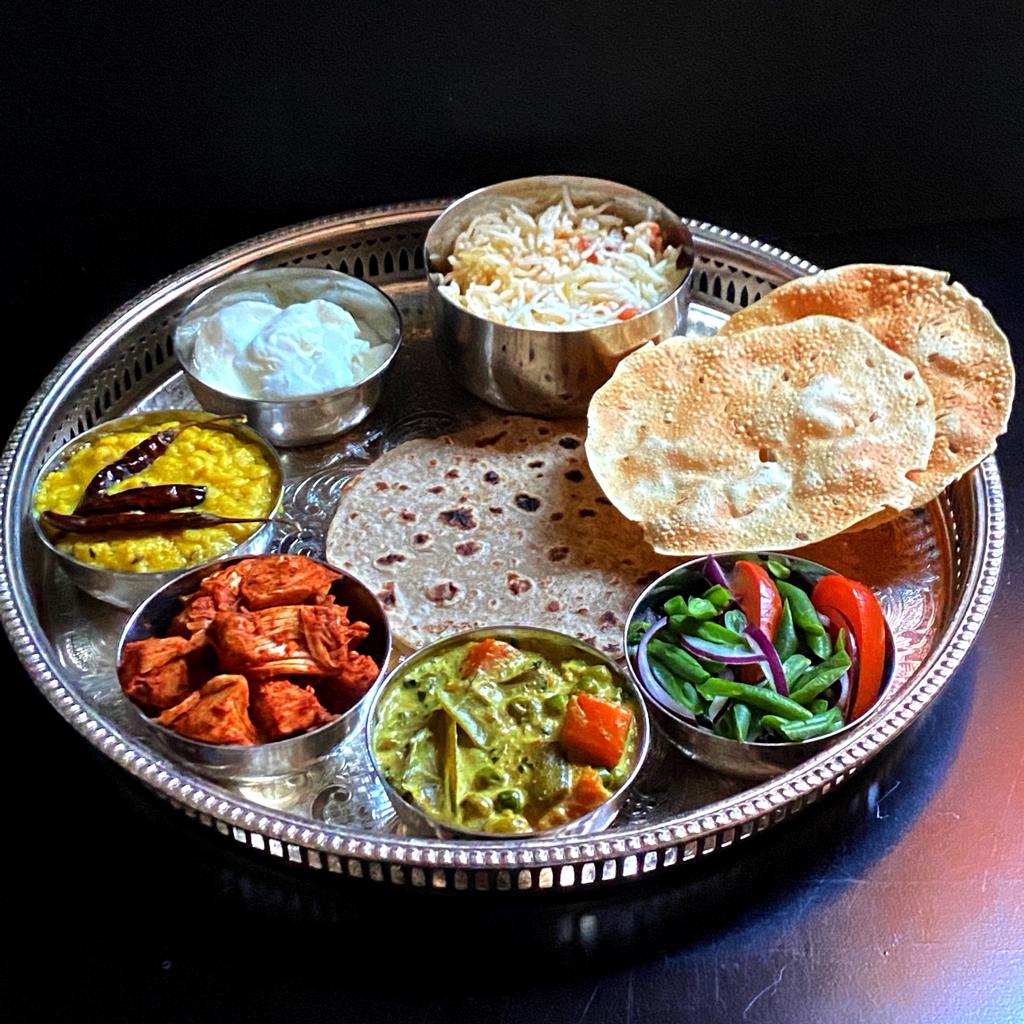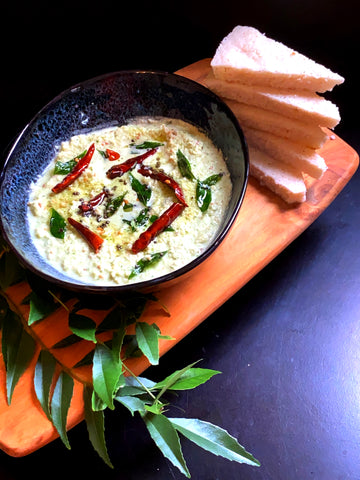Accompaniments to Indian Meals
By Conchita de Souza

I truly believe that in Indian cuisine, accompaniments to a dish elevate a good meal into a great one. The kind that merits labels like ‘mouth-watering’ or ‘sumptuous’. The accompaniments usually complement the central dish by adding a contrast of flavours (sweetness to temper the spiciness), building on textures (such as crunchiness) or providing opposing sensations (cooling to counteract heat).
Additionally, accompaniments can serve to fulfill the Ayurvedic concept of a balanced and nutritious meal being one that contains all six tastes or shad rasa. The six tastes are madhura (sweet), amla (sour), lavana (salty), katu (pungent), tikta (bitter), and kashaya (astringent) and they are tied in with a person’s dosha (constitution), as well as the seasons. By no means am I an Ayurvedic specialist, so if you do wish to know more on this topic, I recommend that you consult an Ayurvedic practitioner.
A thali is a perfect illustration of how accompaniments are seamlessly incorporated into a meal. Thali is the word for ‘plate’ in Hindi and contains numerous dishes compartmentalised in katoris (round steel bowls). It is similar to the Japanese culinary concept of a bento box, but is usually more varied in terms of substance. In a thali, everything from your entree to your dessert is served on the one plate. It is an exciting experience that entices your olfactory senses (particularly those of sight and smell) and whets the appetite even before you take your first bite. Depending on where in Indian you are, a thali could be pure vegetarian (such as a Gujarati thali), with seafood or meat (common coastal regions) or served for a religious festival (the Kerala Sadya, served during the festival of Onam, has up to 20 dishes and is traditionally served on a banana leaf).

Image: Going clockwise, basmati rice, papadam, dhal, potato with fenugreek, gulab jamun dessert and at the centre fried eggplant.
Today’s post explores how you can elevate the food you prepare at home with these simple accompaniments.
-
Pickle - Just like chocolate has a multitude of variations and combinations, so too does pickles. There is no limitation with pickles and you can pickle just about anything. They have a long shelf life as they preserve the fruit or vegetable contained within. Pickles contain chunks of fruit or vegetable and go beautifully with rice and dhal, a simple vegetarian pilaf or with stuffed parathas. Honestly speaking, they can go with everything. My father used to smear pickle on toast for a spicy twist to breakfast. Click here to try our recipe for aubergine pickle or have a go at preparing a pickle curry with our spice blend.

Image: Homemade lemon pickle
-
Chutney - Here we refer to two kinds of chutneys; the first is the sweet/sour kind you get in bottles and combine beautifully with any meal - a full blown thali or a simple sandwich. Click here for a fantastic recipe for an apple or mango chutney which goes well with almost anything, whether it be slathered on a cracker or enjoyed with cooked meat. The second kind of chutneys are popular in south indian cuisine - they can be made from a combination of fresh ingredients like coconut and tomato or mint and coriander. They are served alongside quintessential south indian dishes like dosa, idli and vadas.

Image: A south indian-inspired tempered coconut chutney
-
Raita - This is a perfect accompaniment to biryanis and pilafs. As it is made from curd, it helps to cut down the spiciness of the dish it accompanies but also acts as a souring agent, adding a sensation of tartness. Raita can be prepared with aromatic ground spices like cumin, chaat masala, and chilli, with fresh herbs like mint, coriander and dill or can be made heavier with fresh ingredients like onions, tomatoes and cucumber. My favourite raita is boondi raita, where tiny crisp fried gram flour balls, called boondi, are added to the spiced curd and swell in size.

Image: A simple raita garnished with kashmiri chilli powder, cucumber and mint
-
Papadam - If you are big on texture then papad is the perfect accompaniment to rice-based dishes. These crunchy cracker-like discs are made with lentil flours such as chickpea or black gram flour. Traditionally they are deep fried, but if you are okay to compromise a little on taste, try cooking the papadam in your microwave or on an open flame. I prefer crushing the papad over my rice and curry and mixing it together on nights where I haven’t already devoured the papad as an entree.
-
Pakora - Add these little deep-fried parcels of vegetables (though it can also be fish/chicken) to a simple dhal or kadhi for that extra element of crunch or simply serve them with Chai for a morning or afternoon snack.

Image: Pakoda Khadi
-
Raw vegetables - Don’t underestimate the power of crudites to transform a meal. Raw vegetables as an accompaniment serve multiple purposes; they are often a cooling agent for a spiced-up palate and they provide texture. Most Indian restaurants will serve a ‘salad’ with every meal and this often comprises radish, onion, cucumber and tomatoes finely sliced and sprinkled with lemon juice, chaat masala, chilli powder and black salt. Very popular, with most meals served in restaurants, are rings of raw onions soaked in vinegar (sirke wali piyaz) as it brings in that element of crunch, sourness and pungency.

Image: Tomato rice accompanied by raw vegetables and pickle
Please comment below and tell us what your favourite accompaniment is.

0 comments